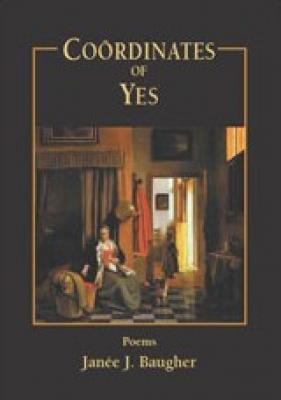REVIEW
Janee J. Baugher’s Coördinates of Yes

Coördinates of Yes by Janee J. Baugher
Ahadada Books, 2010 (92 pages)
ISBN: 9780981274430
Ahadada Books, 2010 (92 pages)
ISBN: 9780981274430
You couldn’t ask for a better or braver traveling companion than poet Janee J. Baugher. Her stunning debut book of poems, Coördinates of Yes (Ahadada Books, 2010) offers the reader reflective and meaningful insights on how to see and navigate through foreign landscapes, grand works of master artists, and the near visible outline of kindred relationships, both past and present. Developed over a lengthy jaunt through Europe, the book positions the vicissitudes of sustained travel against a backdrop of famous classical paintings.
Baugher has an impulse towards relentless movement and this bristling, kinetic energy is exquisitely realized within the contents of her poetic travelogue. Her deft precision as a talented wordsmith is evident throughout this generous book as she carefully examines, measures and weighs her immediate surroundings against her own life’s sweeping trajectory and tumult. In the poem, “Border Crossing: France/Switzerland”, Baugher presents her stranded vista to the reader in vivid, sensual tones: “Livestock bells through/certain mist./Mist levitates/to mingle with a stratus/spiriting over Les Rousses lake. . .The irrepressible stars,/quite recognizable above/the road at my back.”
To travel with Baugher is to set off on various pilgrimages to some of the world’s most enthralling cities and artworks. She writes ekphrasticly—making verbal representation of visual works of art—and leads the reader into re-vivified worlds of curious and compelling beauty. In her poem, “Van Gogh’s Room at Arles,” after the painting by Vincent Van Gogh, she notes that “portraits seem/uncertain of their hooks … With cobalt-green, he’s painted the panes shut—/the air in the room caves in on him.” It is Baugher’s collusion, not only with these masterworks that involve the reader, but the urgent manner in which she is able to inhabit the intention and persona of the artists themselves. As though she is in some kind of psychic communion with the great spirits of these monumental artistic legends, Baugher is able to deftly translate her transpersonal dance with them onto the page.
Baugher intentionally jostles and jars the reader, as though one is sharing a clattering train compartment with her on one of her far-flung European adventures. The balance between perpetual travel and the viewing of great art both disorients and compels one to enter a transcendent realm. At the heart of Coördinates of Yes is the idea that every one of us is a transient wanderer who must be wide open to experience the shifting colors and temperatures of the engaged imagination. The poet also suggests to the reader that to effectively engender a meaningful relationship with one’s self, one must peer through the human lens of history as it is represented within visual art.
From her poem, “The Execution of Lady Jane Grey—after the painting by Paul Delaroche” she writes: “The irrefutable luminance of her dress/is almost too much on the eyes./If the executioner focuses on her nape,/the axe could hesitate there./She feels the bole pressed to her cheek./She becomes the stump of wood,/dead oak which once stood in sight of stars.” Like the doomed, short-lived queen in the Delaroche painting, the reader is transfixed by the urgency and peril of the moment. Baugher renders a keen response and interpretation of the artwork and welcomes in the reader to actively participate in inhabiting the emotional tenor of this deep exploration. Ekphrastic poetry brings renewed attention to visual art but it is Baugher’s emphatic insistence on entering the moment so nakedly, so completely, that makes this journey and excavation of artistic intentions and nuances so rewarding.
In “The Great Door of Rouen Cathedral, Grey Day” after the painting by Claude Monet, Baugher’s hallucinatory revelation offers the reader an insight into the Impressionist painter’s own extraordinary genius: “What lay within this church? A reverie/known only to the blind? Did he ever enter/those portals—the ones I now see opening?” Her ekphrastic poems create an intimate, indelible kinship with both the poet herself, as invaluable eyewitness, and the visionaries she chooses to embrace: Antoine de Saint-Exupery, Jean Francois Millet, Gustave Caillebotte, and Pierre Bonnard to name a few.
I can’t think of a better way to comingle with the terrain of the world than by going on a sojourn with this generous poet. In one of my favorite poems, “Draining West,” she ponders: “Continent what have you done?/Awake all last night at a Dublin pub/and today you spit me back./Must I now know my final destination./the conjugation of new tenses?” After engaging with her first book of elegant poetry, I am anxious for Baugher to lead me through more enchanted dreamscapes and altered states of being and transforming with her next book.
Gerard Wozek is the author of the poetry collection Dervish (Gival Press, 2001) and the short story compilation,
Postcards from Heartthrob Town (Southern Tier Editions, 2007). He is currently working on a memoir of growing up in a closed adoption.
He teaches creative writing at Robert Morris University in Chicago.
